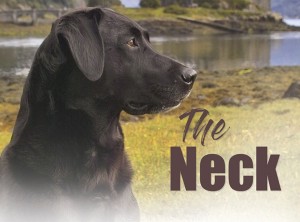The Neck
Click here to read the complete article
 By Wendell Sammet
By Wendell Sammet
The neck is one of the functional components of the dog: the others being the spinal column, the forelimbs and the hindlimbs.
The neck’s (cervical spine’s) primary function is to support the head, thus creating the preferred head carriage for its breed, joined by a slightly arched neckline imparting strength.
The cervical spine, the neck, joins to the fourth thoracic spine of the spinal column. It is composed of numerous muscles and ligaments, all with specific functions. Together they create stability and exert total control of the head movement. They shift the dog’s center of gravity from side to side in turns, and raise and depress the neck. They play a major role in producing lift and forward motion for the front assembly, and provide a major influence to maintain equilibrium.
While running, the dog leans forward extending his head and neck forward in order to lengthen his stride and shift more weight onto the forehand. This enhances stability. When stopping abruptly, the dog raises its head and neck immediately throwing the center of gravity backwards, acting as a brake.
The intricate skeletal structure of the neck is composed of seven cervical vertebrae, beginning with the atlas and axis. Their appearance is unlike the other five vertebrae due to their specialized functions. As their names imply, the unique formations of the atlas and axis allow rotational movement of the head.
Their articulation at the skull produces the free movement of the head. The front attachment is to the head, the posterior is joined at the thoracic spine. The strong, broad attachment points of these two vertebrae create the crucial joining of the network of muscles and ligaments controlling the functionality of the neck.
Click here to read the complete article
Short URL: http://caninechronicle.com/?p=195072
Comments are closed












